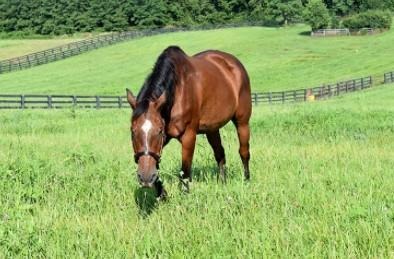By Katie Pratt
Horses at a Central Kentucky career and technical high school have lush paddocks to graze on this school year thanks to help from the University of Kentucky College of Agriculture, Food and Environment.
Locust Trace AgriScience Center is a school in Lexington that introduces high school students in Fayette and Woodford counties to many agriculture disciplines. Equine science is one of the more popular areas. During the school year, horses on loan to the school graze the four on-campus paddocks when they are not interacting with students. But with more horses than paddocks, the fields were overgrazed, and it was time to improve them.
“Last year, I served as the farm manager, and I knew these paddocks were pretty thin on forages for our horses,” said Nicki Jones, Locust Trace co-op facilitator. “With no students being on campus, we saw it as the prime opportunity to call on the people at UK to walk us through a renovation.”

A horse grazing at Locust Trace AgriScience Center.
The school contacted Krista Lea, UK horse pasture evaluation program coordinator, and Jimmy Henning, UK forage extension specialist. They advised the school personnel to kill out the existing vegetation and guided them through reseeding the pastures and managing them for the future.
Lea suggested they reseed the paddocks in a tall fescue that could handle the high grazing pressure. Through a donation from Pennington Seed, they secured Lacefield Max Q II, a tall fescue variety developed at UK that contains a novel endophyte. The novel endophyte allows animals to graze the grass without having adverse health effects. Gabriel Roberts, UK field technician, helped the school sow the grass seed.
“I like the fact that I can look out and I can see that the horses we have are on good grass,” said Fallon Jackson, Locust Trace equine sciences instructor. “They are getting what they need, and I don’t have to worry about body condition scores going down because the forage that they are eating is not good enough.”
Lea continues to advise the school on ways to use pasture rotation to give the pastures ample time for recovery and regrowth.
“Each pasture will have a fair number of horses on it with pretty high grazing pressure for a couple of weeks. Then the horses will be rotated off for two to four weeks, and hopefully that will give the pastures plenty of time to regrow,” Lea said. “Even though they are going to have high grazing pressure, by using good management, a dry lot and even feeding some hay in stalls, they should be able to maintain it reasonably well. “
The new grass also will provide teaching opportunities on the importance of quality forages to equine health.
“I think it will be a good opportunity to teach the students about the importance of rotation and not overgrazing and that what you do in the wintertime is going to affect what happens in the spring,” Jones said.
Source : uky.edu